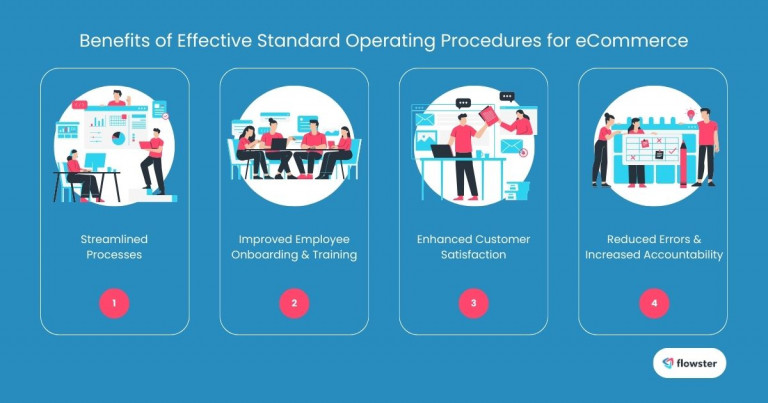In the fast-paced world of eCommerce, efficiency is key. One of the most effective ways to achieve operational excellence is through creating effective standard operating procedures (SOPs). These documented processes help businesses maintain consistency, improve performance, and ensure compliance across various operations.
SOPs serve as a roadmap for teams, guiding them through essential tasks like order fulfillment and customer service. In this guide, we’ll explore the significance of SOPs in eCommerce, the trends that are shaping their development in 2025, and provide you with step-by-step instructions to create SOPs that work for your business. Let’s dive in!
Article Outline
Understanding SOPs in eCommerce
Standard Operating Procedures (SOPs) are crucial in the eCommerce landscape. They provide clarity in operations, help maintain quality control, and enhance customer satisfaction. Let’s break down what SOPs are and why they matter for your business.
Definition and Importance
SOPs are detailed documents that outline the step-by-step processes necessary to complete specific tasks within an organization. In the context of eCommerce, they ensure that everyone on your team understands their roles and responsibilities. This consistency is essential for delivering a seamless customer experience and maintaining operational standards.
The importance of SOPs cannot be overstated. They help reduce errors, streamline workflows, and improve communication among team members. By creating effective standard operating procedures, companies can foster a culture of efficiency and accountability.
Benefits of Implementing SOPs
Implementing SOPs in your eCommerce operations comes with numerous benefits:
- Streamlined Processes: SOPs provide clear instructions, enabling employees to perform tasks efficiently. This reduces confusion and accelerates your operational pace.
- Improved Employee Onboarding and Training: New hires can quickly get up to speed with well-documented procedures. This not only saves time but also enhances the quality of training.
- Enhanced Customer Satisfaction: Consistent procedures lead to consistent results, which translates into better service for your customers. When customers know what to expect, their satisfaction levels rise.
- Reduced Errors and Increased Accountability: SOPs create a framework for accountability. When procedures are clearly outlined, it is easier to identify where things went wrong, allowing for timely corrections.
In summary, creating effective standard operating procedures is not just about documentation; it’s about building a solid foundation for your eCommerce business. For more insights on enhancing your eCommerce operations, check out this article: 7 Proven Strategies to Supercharge eCommerce Workflows.

Trends Shaping SOPs in 2025
As we look to the future, several trends are influencing how businesses develop their Standard Operating Procedures (SOPs) in the eCommerce space. Understanding these trends is essential for creating effective standard operating procedures that align with industry advancements and consumer expectations. Let’s explore some of the key trends that will shape SOPs in 2025.
The Rise of Automation and AI in Operational Processes
In 2025, automation and artificial intelligence are set to play a significant role in eCommerce operations. With the increasing prevalence of AI tools, businesses can automate routine tasks, such as inventory management, order processing, and customer service. This automation allows teams to focus on higher-value activities while maintaining efficiency.
The incorporation of AI into SOPs ensures that these procedures are not only effective but also adaptable. Businesses can leverage data to refine their processes continually, making creating effective standard operating procedures a dynamic experience rather than a static one.
Sustainability Practices and Their Impact on SOPs
Sustainability is no longer just a buzzword; it’s an essential consideration for modern businesses. In 2025, eCommerce companies are prioritizing sustainable practices, and this focus will shape their SOPs. From sourcing materials to packaging, such as corrugated packaging design and shipping, sustainability will influence every aspect of operations.
By integrating eco-friendly practices into SOPs, businesses can not only meet consumer demand for sustainable options but also enhance their brand reputation. Creating effective standard operating procedures that align with sustainability goals demonstrates a commitment to responsible business practices.
Consumer Behavior Shifts and Their Dictation of Operational Changes
As consumer preferences evolve, so too must the SOPs that guide eCommerce operations. In 2025, we expect to see significant shifts in consumer behavior, driven by factors such as personalization, convenience, and rapid delivery expectations.
To stay competitive, businesses will need to adapt their SOPs to respond to these changes. This means revising processes to enhance the customer experience, such as implementing faster fulfillment methods or providing personalized service options. By creating effective standard operating procedures, companies can remain agile and responsive to consumer demands.
In conclusion, understanding the trends shaping SOPs in 2025 is crucial for eCommerce businesses. By adapting to automation, sustainability, and changing consumer behaviors, companies can create robust SOPs that ensure operational success. For more insights on streamlining eCommerce processes, check out this article: Ecommerce Process Management to Automate Efficiency.From sourcing materials to packaging, such as corrugated packaging design and shipping, sustainability will influence every aspect of operations.
Capture Your Processes in Minutes!
Steps to Create Effective Standard Operating Procedures
Creating Standard Operating Procedures (SOPs) is a strategic process that can greatly enhance the efficiency of your eCommerce operations. Here are the essential steps to ensure you are creating effective standard operating procedures that meet the needs of your business and your customers.
1. Identifying Core Processes
The first step in developing effective SOPs is to identify the core processes that drive your business. These may include order fulfillment, customer service, inventory management, and returns processing.
By focusing on these areas, you can ensure that your SOPs address the most critical aspects of your operations. Clearly defined processes help streamline workflows and eliminate redundancies, setting a solid foundation for your SOPs.
2. Engaging Stakeholders in the SOP Development Process
Next, it’s important to engage stakeholders in the SOP development process. Involving team members who are directly involved in these processes allows you to gather valuable insights and feedback.
This collaborative approach not only enhances the quality of your SOPs but also fosters a sense of ownership among employees. When everyone has a say in creating effective standard operating procedures, they are more likely to adhere to them.
3. Writing Clear and Concise Procedures
Once you have gathered input from stakeholders, it’s time to draft your SOPs. Writing clear and concise procedures is critical. Use straightforward language and a logical structure, breaking down each task into manageable steps.
Avoid jargon and ensure that anyone can follow the SOPs, regardless of their experience level. Remember, the goal is to provide a user-friendly document that everyone can understand.
4. Implementing and Testing the SOPs
After drafting your SOPs, the next step is implementation. Roll out the procedures to your team and ensure everyone understands their roles. Testing these procedures in real scenarios is vital to identify any gaps or areas for improvement.
Gather feedback from your team after the initial implementation. This allows you to refine and enhance your SOPs, ensuring they effectively support your operations.
5. Training Staff and Ensuring Compliance
The final step in creating effective standard operating procedures is training your staff. Provide comprehensive training sessions that explain the SOPs and their importance. This will help employees feel confident in following the procedures.
Additionally, establish a system for monitoring compliance and performance. Regularly review your SOPs to ensure they remain relevant and effective as your business evolves.
In summary, developing effective SOPs requires careful planning and collaboration. By following these steps, you can create a set of procedures that streamline your operations and enhance overall efficiency. For further insights on overcoming common challenges in eCommerce workflows, check out this article: Common Bottlenecks in eCommerce Workflows: How to Fix.
Flowster's AI-Driven Automation
Case Studies and Success Stories
When it comes to creating effective standard operating procedures, real-world examples can provide valuable insights into how businesses have successfully implemented SOPs to streamline their operations. Let’s explore a notable case study that highlights the transformative power of SOPs in eCommerce.
Examples of eCommerce Businesses that Benefited from Well-Crafted SOPs
In a recent discussion, Karl Keller, the owner of an online apparel store, shared his experience using Flowster to implement effective SOPs in his business. Previously, Karl relied on traditional tools like Google Docs and Excel spreadsheets, which became cumbersome and inefficient as his operations grew.
With Flowster, he discovered a modular and scalable approach to managing his workflows. This platform enabled him to create SOPs that were not only easy to integrate into existing processes but also adaptable to future needs. He emphasized the following key strengths of Flowster:
- Modularity: Carl appreciated how individual components could be seamlessly integrated into various workflows, allowing for customization based on specific tasks.
- Scalability: Flowster’s design supports businesses of all sizes, making it easy to manage both daily activities and larger quarterly tasks.
- Repeatability: The platform allows for plug-and-play efficiency, meaning processes can be repeated with minimal adjustments, ensuring consistency and reliability.
Karl noted that the structured nature of Flowster instilled discipline within his team and facilitated effective task implementation, especially as he transitioned from a team of four to working with a virtual assistant. This shift not only boosted productivity but also enhanced the clarity of operations.
Karl’s story emphasizes how creating effective standard operating procedures can significantly impact a business, regardless of its size or industry. For more insights into how SOPs can transform your eCommerce operations. I encourage you to watch the full discussion in this YouTube video:
Flowster Case Study with Karl Keller
Conclusion
In the competitive world of eCommerce, creating effective standard operating procedures is more than just a best practice; it’s a necessity for success. SOPs help streamline operations, enhance team efficiency, and improve customer satisfaction, all while ensuring that your business can adapt to changing trends.
By understanding the importance of SOPs, following the steps to create them, and staying aware of the trends shaping their development, you can build a solid foundation for your eCommerce operations. The case studies and success stories we’ve explored illustrate that effective SOPs are crucial for businesses of all sizes, providing the structure needed to thrive in a rapidly evolving market.
If you’re ready to get started, you can easily access free SOP templates to help you on your journey. Visit Flowster’s Marketplace to find templates that can kickstart your SOP development today!




